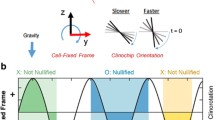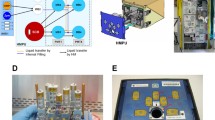Abstract
The fast-rotating 2-D clinostat, a ground-based facility for investigations in simulated microgravity, is mainly used for experiments with cell suspensions. Here, we describe the adaptation of a 2-D clinostat for adherent cell investigations using commercially available slide flasks. As a gradient of residual accelerations is present in the slide flasks during clinorotation, the range of maximal g-values has to be adjusted to the investigated cells and type of analysis. For gene expression analysis, a harvesting slide chamber was constructed, allowing collection of cells exposed to defined g-values. Using this slide chamber, human 1F6 melanoma cell line, exposed in the ranges of ≤0.012 g, ≤0.024 g, or ≤0.036 g for 24 h, was harvested and the respective mRNA levels of guanylyl cyclase A (GC-A), an enzyme catalyzing cyclic GMP synthesis, were determined by real-time quantitative PCR analysis. Our results show that the down-regulation of GC-A mRNA levels in 1F6 melanoma cells depends on the residual acceleration values with a maximal reduction at ≤0.012 g. We further used the slide flasks by the clinorotation of murine RAW 264.7 macrophage cell line for f-actin analysis. The laser scanning microscopy images of cells exposed to g-values of ≤0.006 g for 1 h show an increase in the cell size of clinorotated cells, but no rearrangement in the f-actin filament system compared to static 1-g controls. Thus, 2-D clinostats equipped with slide flasks can be used for adherent cell experiments, however, the maximal g-values have to be carefully considered.




Similar content being viewed by others
References
Briegleb, W.: A model for weightlessness-simulation using microorganisms. Naturwissenschaften 54, 167 (1967)
Briegleb, W.: Some qualitative and quantitative aspects of the fast-rotating clinostat as a research tool. ASGSB Bull. 5, 23–30 (1992)
Brungs, S., Hauslage, J., Hilbig, R., Hemmersbach, R., Anken, R.: Effects of simulated weightlessness on fish otolith growth: clinostat versus rotating-wall vessel. Adv. Space Res. 48, 792–798 (2011)
Hemmersbach, R., Von der Wiesche, M., Seibt, D.: Ground-based experimental platforms in gravitational biology and human physiology. Signal Transduct. 6, 381–387 (2006)
Herranz, R., Anken, R., Boonstra, J., Braun, M., Christianen, P.C., de Geest, M., Hauslage, J., Hilbig, R., Hill, R.J., Lebert, M., Medina, F.J., Vagt, N., Ullrich, O., van Loon, J.J., Hemmersbach, R.: Ground-based facilities for simulation of microgravity: organism-specific recommendations for their use, and recommended terminology. Astrobiology 13, 1–17 (2013)
Hughes-Fulford, M.: Function of the cytoskeleton in gravisensing during spaceflight. Adv. Space Res. 32, 1585–1593 (2003)
Hughes-Fulford, M., Lewis, M.L.: Effects of microgravity on osteoblast growth activation. Exp. Cell Res. 224, 103–109 (1996)
Ivanova, K., Le Poole, I.C., Gerzer, R., Westerhof, W., Das, P.K.: Effect of nitric oxide on the adhesion of human melanocytes to extracellular matrix components. J. Pathol. 183, 469–476 (1997)
Ivanova, K., Das, P.K., van den Wijngaard, R.M., Lenz, W., Klockenbring, T., Malcharzyk, V., Drummer, C., Gerzer, R.: Differential expression of functional guanylyl cyclases in melanocytes: absence of nitric-oxide-sensitive isoform in metastatic cells. J. Invest. Dermatol. 116, 409–416 (2001)
Ivanova, K., Zadeh, N.H., Block, I., Das, P.K., Gerzer, R.: Stimulation of cyclic GMP efflux in human melanocytes by hypergravity generated by centrifugal acceleration. Pigm. Cell Res. 17, 471–479 (2004)
Ivanova, K., Eiermann, P., Tsiockas, W., Hauslage, J., Hemmersbach, R., Gerzer, R.: Natriuretic peptide-sensitive guanylyl cyclase expression is down-regulated in human melanoma cells at simulated weightlessness. Acta Astronaut. 68, 652–655 (2011)
Klaus, D.M., Todd, P., Schatz, A.: Functional weightlessness during clinorotation of cell suspensions. Adv. Space Res. 21, 1315–1318 (1998)
Kong, X., Wang, X., Xu, W., Behera, S., Hellermann, G., Kumar, A., Lockey, R.F., Mohapatra, S., Mohapatra, S.S.: Natriuretic peptide receptor a as a novel anticancer target. Canc. Res. 68, 249–256 (2008)
Meloni, M.A., Galleri, G., Pippia, P., Cogoli-Greuter, M.: Cytoskeleton changes and impaired motility of monocytes at modelled low gravity. Protoplasma 229, 243–249 (2006)
Meloni, M.A., Galleri, G., Pani, G., Saba, A., Pippia, P., Cogoli-Greuter, M.: Space flight affects motility and cytoskeletal structures in human monocyte cell line J-111. Cytoskeleton 68, 125–137 (2011)
Moes, M.J.A., Gielen, J.C., Bleichrodt, R.J., van Loon, J.J.W.A., Christianen, P.C.M., Boonstra, J.: Simulation of microgravity by magnetic levitation and random positioning: effect on human A431 cell morphology. Microgravity Sci. Technol. 23, 249–261 (2011)
Raschke, W.C., Baird, S., Ralph, P., Nakoinz, I.: Functional macrophage cell lines transformed by Abelson leukemia virus. Cell 15, 261–267 (1978)
Thiel, C.S., Paulsen, K., Bradacs, G., Lust, K., Tauber, S., Dumrese, C., Hilliger, A., Schoppmann, K., Biskup, J., Golz, N., Sang, C., Ziegler, U., Grote, K.H., Zipp, F., Zhuang, F., Engelmann, F., Hemmersbach, R., Cogoli, A., Ullrich, O.: Rapid alterations of cell cycle control proteins in human T lymphocytes in microgravity. Cell Commun. Signal 10, 1 (2012)
Ulbrich, C., Pietsch, J., Grosse, J., Wehland, M., Schulz, H., Saar, K., Hubner, N., Hauslage, J., Hemmersbach, R., Braun, M., van Loon, J., Vagt, N., Egli, M., Richter, P., Einspanier, R., Sharbati, S., Baltz, T., Infanger, M., Ma, X., Grimm, D.: Differential gene regulation under altered gravity conditions in follicular thyroid cancer cells: relationship between the extracellular matrix and the cytoskeleton. Cell. Physiol. Biochem. 28, 185–198 (2011)
Acknowledgments
The present study was supported by the Program Directorate of Human Spaceflight, DLR, Cologne, Germany. The authors acknowledge that this study forms a part of a Ph.D. thesis of Peter Eiermann (Helmholtz Space Life Sciences Research School at the German Aerospace Center, Institute of Aerospace Medicine, Cologne, Germany), and the Bachelor thesis of Sascha Kopp (University of Applied Science, Bonn-Rhein-Sieg, Germany).
Author information
Authors and Affiliations
Corresponding author
Rights and permissions
About this article
Cite this article
Eiermann, P., Kopp, S., Hauslage, J. et al. Adaptation of a 2-D Clinostat for Simulated Microgravity Experiments with Adherent Cells. Microgravity Sci. Technol. 25, 153–159 (2013). https://doi.org/10.1007/s12217-013-9341-1
Received:
Accepted:
Published:
Issue Date:
DOI: https://doi.org/10.1007/s12217-013-9341-1




